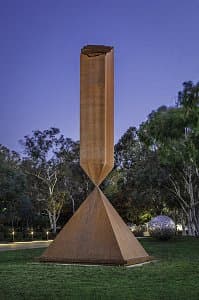

Barnett Newman
Learn moreBroken obelisk 1963/67 / 2005
© 2018 The Barnett Newman Foundation, New York/ARS, New York/Copyright Agency The Barnett Newman Foundation
More detail | PermalinkBarnett Newman’s Broken Obelisk 1963/67 is powerfully symbolic and acutely political. The monumental sculpture combines the qualities of ancient forms with the geometry of modern architecture and materials. The genesis of the work is traceable through, and runs parallel to, Newman’s painting practice; it is, moreover, closely entwined with his small but impressive sculptural output. The artist’s first three-dimensional work, Here I 1950, forecasts the emphatic vertically of his forms while his final sculptures, Zim Zum I and Zim Zum II 1969, suggest mystic, all-enveloping spaces that expand beyond human scale towards the architectural.[1] Although Newman himself differentiated between the ‘planar’ and ‘volumetric’ problems of his work, he wanted both his paintings and sculpture to ‘give the onlooker a sense of place, a sense of being there’.[2]
Here I—comprising two slender wooden uprights, set into a mounded square base crate, covered with plaster—was shown at Betty Parsons Gallery, New York, in 1951.[3] In 1962, after several hiatuses he returned to Here I, casting two bronze versions and making adaptions to the base. Ideas for his next sculptures developed quickly. For Here II 1965, made in weathering steel, three uprights of equal height, one thick and two thin, are set on truncated pyramids grouped on a base. Here III 1965–66, combining stainless and weathering steel, likewise suggests a logical progression, as if Newman decided to isolate and enlarge the central section of the preceding work.[4] Because the bases are elevated slightly, Here II and Here III both seem to hover. The emphasis on the relationship between upright form and its base is an idea that finds full articulation in Broken Obelisk, as Armin Zweite astutely observed: ‘An inverted obelisk, its shaft broken, is mounted on a pyramid in such a way that their tips touch and slightly penetrate each other—an upward-moving force meets a downward-sweeping movement, or, to put it another way, a vertical load is supported by an opposing thrust.’[5]
Broken Obelisk seems to have been influenced by several practical concerns. Initially, as Newman’s sketches show, the pyramid was flatter and more squat and the obelisk much thinner, so it appeared more precariously balanced. To develop its dimensions while retaining the teasing connection between the massive forms, he relied on Lippincott, a Connecticut fabricator specialising in working with artists to build large-scale sculpture. The monumentally of the final sculpture is, of course, key, and engineering drawings demonstrate how the pyramid became taller and the relationship between the obelisk and pyramid more elegant, with the two elements meeting in diagonal cross formation serving to highlight the upper broken end of the obelisk. A full-scale model, produced to test the spatial effects, confirmed the final configuration, and a second Broken Obelisk was fabricated. The works were installed in front of the Seagram Building in New York and adjacent to the Corcoran Gallery of Art in Washington in October 1966. Broken Obelisk also developed a memorial quality as demonstrated by the third exemplar installed within the reflecting pool near the Rothko chapel for the Menil Collection in Houston and dedicated to the memory of Martin Luther King. As Newman commented, writing in the year of King’s death, ‘I hope I have transformed its tragic content into a glimpse of the sublime’.[6]
Lucina Ward
[1] Here I (Menil Collection, Houston), Zim Zum I (San Francisco Museum of Modern Art) and Zim Zum II (Kunstsammlung Nordrhein-Westfalen, Dusseldorf).
[2] Newman, as he stated in a 1966 interview with Washington Post critic Andrew Hudson, considered the elements of his practice quite separately: ‘I do not consider my sculpture to be a three-dimensional equivalent of my paintings. I think the problems are altogether different. Painting is a planar art. Sculpture involves for me the problem of volume. But I hope that both the sculpture and the painting give the onlooker a sense of place, a sense of being there’. Barnett Newman, Barnett Newman: Selected writings and interviews, University of California Press, Berkeley, 1992, p 273.
[3] The shaped and amorphous plaster surface of Here I, the edges of the upright elements in particular, prompted parallels between the sculpture and Newman’s painted ‘zips’.
[4] Both Here II 1965 (National Gallery of Canada, Ottawa and Davros Collection, Switzerland) and Here III 1965–66 (Öffentliche Kunstsammlung, Basel and Nasher Sculpture Center, Dallas) were produced with the Treitel-Gratz, a foundry on Long Island.
[5] Armin Zweite, Barnett Newman: Paintings, sculptures, works on paper, Hatje Cantz Publishers, Ostfildern-Ruit, 1999, p 269.
[6] Quoted in Harold Rosenberg, Barnett Newman, Harry N Abrams, New York, 1978, p 77.

